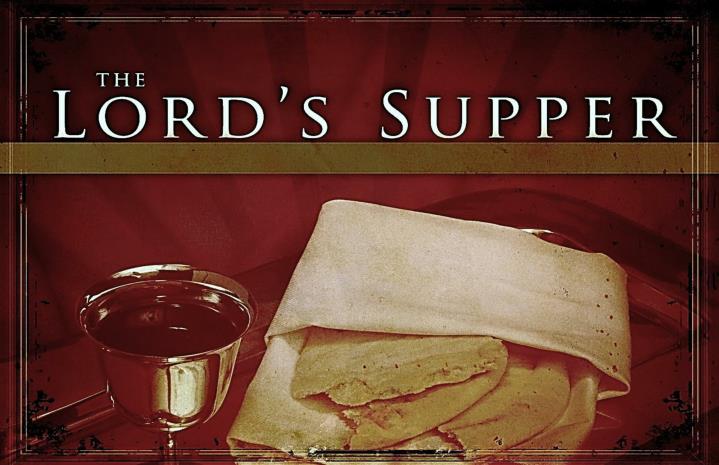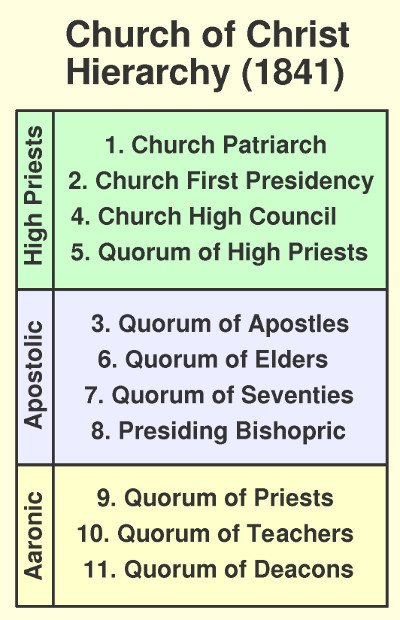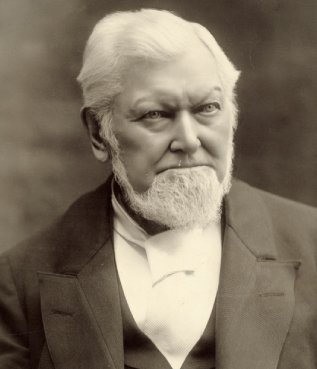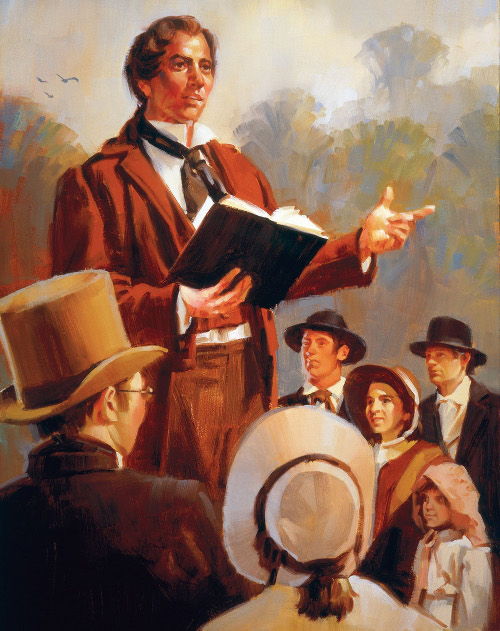
by John P. Pratt
19 Sep 2020, Trumpets (PH), Equinox (E), New Year (S)
©2020 by John P. Pratt. All rights Reserved.
|
1. Sacrament 2. Tithing 3. Marriage 4. Law of Church 5. Priesthood 6. Infallible 7. Revelation 8. Conclusion Notes |
Many changes have been made to the Church of Jesus Christ of Latter-day Saints since the death of Joseph and Hyrum Smith, some of which are reviewed in this article. Whether or not these changes were inspired by the Lord or whether they were simply logical administrative updates is not discussed. Before attempting to make any such judgments about their origin, it first seems important to note what some of the more important changes have been.
All of the changes presented herein are documented in LDS scripture, especially the Doctrine and Covenants, in which the Lord reveals His will concerning the Church and its procedures and ordinances. In an attempt to make it completely clear that the changes are what the Lord instructed at the beginning, no references to journals or historical records of the time are used, but only to canonized LDS scripture.
 |
It is expedient that the church meet together often to partake of bread and wine in the remembrance of the Lord Jesus;
And the elder or priest shall administer it; and after this manner shall he administer it--he shall kneel with the church and call upon the Father in solemn prayer, saying:
(The prayer on the bread follows.)
The manner of administering the wine--he shall take the cup also, and say:
(The prayer on the wine, not water, follows.) -- D&C 20:75-79.
After these initial instructions were given, the Word of Wisdom was revealed by the Lord in 1833. Some assume that this revelation, which states that it is not good to drink wine, may be the justification not to use wine in the sacrament. On the contrary, lest there be any confusion, that very revelation commands that wine be used for that sacred ordinance:
That inasmuch as any man drinketh wine or strong drink among you, behold it is not good, neither meet in the sight of your Father, only in assembling yourselves together to offer up your sacraments before him.
And, behold, this should be wine, yea, pure wine of the grape of the vine, of your own make. -- D&C 89:5-6
From these few verses we see many elements of the sacrament which are no longer practiced:
The most important of these changes is that red wine is no longer used to represent the blood of the suffering Savior, even though in the Word of Wisdom the Lord commands that wine should be used. Seeing how Isaiah, in his revelations about the last days, explicitly states that holy ordinances will be changed, resulting in breaking the everlasting covenant (Isa. 24:5-7), it becomes imperative to know if this changing of the wine to be water was inspired or not!
Wine made by the Church in St George, Utah, was used in the sacrament in the 1800s. The justification given by the Church for changing to water in the sacrament comes from D&C 27:2, which covers the case when wine is not available. It provides the option that in an emergency something else could be substituted in place of the usual emblems. Water is not explicitly mentioned. That exception for emergencies has been extrapolated to replace wine entirely with water. A bishop using wine now for the sacrament could lead to disciplinary action against him. Thus, one needs to ask if the Lord commanded these changes or whether it was altered solely for administrative convenience.
 |
Verily, thus saith the Lord, I require all their surplus property to be put into the hands of the bishop of my church in Zion,
For the building of mine house, and for the laying of the foundation of Zion and for the priesthood, and for the debts of the Presidency of my Church.
And this shall be the beginning of the tithing of my people.
And after that, those who have thus been tithed shall pay one-tenth of all their interest annually; and this shall be a standing law unto them forever, for my holy priesthood, saith the Lord.
Verily I say unto you, it shall come to pass that all those who gather unto the land of Zion shall be tithed of their surplus properties, and shall observe this law, or they shall not be found worthy to abide among you. -- D&C 119:1-5.
That is, when one is first baptized and joins the Church, he is required to donate all of his surplus property to the bishop. Thereafter, he is to pay to the bishop one-tenth of his interest annually.
There have been three important changes made to this law. First, the initial requirement of paying all surplus property has been entirely dropped.
Second, the word "interest" has been redefined by Church leaders from its common meaning of "increase in investments" to mean "one's total income from all sources". Thus, instead of paying of a tenth of one's "interest", which was interpreted in the Prophet Joseph's day as "increase in net worth", it has been changed to a tenth of all net income, such as one's entire monthly paycheck. The basis for calculating tithing was never considered to include income needed for food, clothing, housing, and taxes, but only the surplus above amounts needed for living. The word "surplus" in the revelation appears to be used as a synonym for "interest".
Thirdly, tithing was paid annually. That was especially important for farmers, who might not know if they have made any increase in their net worth until after the harvest. That also applies to almost all who are self employed or who had any big medical expenses during the year.
The most important of these changes is the requirement to pay a tenth of all income! That has made the corporate LDS Church so rich that it has had difficulty in knowing what to use all of that money for. They have built a huge shopping mall in downtown Salt Lake City, costing billions of dollars, and are planning an entire city for half a million people in Florida.
One story which is repeated often by Church leaders is of Sister Smith who was destitute, but went to the ward clerk to pay her "widow's mite" of tithing anyway. The ward clerk tells her that she does not need to pay anything. She insists on paying anyway, expecting blessings for doing so. The hearer assumes that the ward clerk is out of line for telling her not to pay her tithing, but he is in fact reminding her that tithing is paid only on surplus, of which she has none.
 |
There was a section in the 1835 Doctrine and Covenants about marriage to make it clear just what was the Church's official stance on marriage. Here it is in full:
According to the custom of all civilized nations, marriage is regulated by laws and ceremonies: therefore we believe, that all marriages in this church of Christ of Latter Day Saints, should be solemnized in a public meeting, or feast, prepared for that purpose: and that the solemnization should be performed by a presiding high priest, high priest, bishop, elder, or priest, not even prohibiting those persons who are desirous to get married, of being married by other authority. We believe that it is not right to prohibit members of this church from marrying out of the church, if it be their determination so to do, but such persons will be considered weak in the faith of our Lord and Savior Jesus Christ.
Marriage should be celebrated with prayer and thanksgiving; and at the solemnization, the persons to be married, standing together, the man on the right, and the woman on the left, shall be addressed, by the person officiating, as he shall be directed by the holy Spirit; and if there be no legal objections, he shall say, calling each by their names: "You both mutually agree to be each other's companion, husband and wife, observing the legal rights belonging to this condition; that is, keeping yourselves wholly for each other, and from all others, during your lives." And when they have answered "Yes," he shall pronounce them "husband and wife" in the name of the Lord Jesus Christ, and by virtue of the laws of the country and authority vested in him: "may God add his blessings and keep you to fulfil your covenants from henceforth and forever. Amen."
The clerk of every church should keep a record of all marriages, solemnized in his branch.
All legal contracts of marriage made before a person is baptized into this church, should be held sacred and fulfilled. Inasmuch as this church of Christ has been reproached with the crime of fornication, and polygamy: we declare that we believe, that one man should have one wife; and one woman, but one husband, except in case of death, when either is at liberty to marry again. It is not right to persuade a woman to be baptized contrary to the will of her husband, neither is it lawful to influence her to leave her husband. All children are bound by law to obey their parents; and to influence them to embrace any religious faith, or be baptized, or leave their parents without their consent, is unlawful and unjust. We believe that husbands, parents and masters who exercise control over their wives, children, and servants and prevent them from embracing the truth, will have to answer for that sin. -- 1835 D&C 101 (replaced in 1876 by D&C 132).
This section was in that sacred book until 1876 when it was replaced by section 132. One important feature of this official statement on marriage which has been changed is that currently marriages performed within the walls of a Mormon temple are not at all open to the public, as required in the first sentence above. Even younger brothers and sisters are not allowed to attend the wedding of their sibling if they are too young to qualify for a "temple recommend" to allow them to attend. Relatives who are not members of the Church are also excluded. This practice has caused much grief to so many who were not allowed to attend the wedding of their loved one.
Where did this exclusion practice begin? It is unknown in nearly every other church. It began in the late 1800s when the practice of polygamy was illegal and so marriages began for the first time to be practiced in the temples where sheriffs were not allowed to attend, or to even know about the secret marriages. The practice of temple marriage continues to this day, a century after polygamy had been abandoned, even though it fails to meet the original requirement of being open to the public.
Until last year, Mormons who chose not to be married in the temple were considered weak in the faith and had to wait an entire year to be sealed in the temple. Fortunately, that practice has now been dropped and a couple can be married civilly and then sealed for time and eternity in the temple that same day. Thus, all of the family may again be invited to attend the wedding.
 |
In case there is any doubt that these are commandments, the section begins:
... hearken and hear and obey the law which I shall give unto you. -- D&C 42:2
First, several of the Ten Commandments are mentioned, with some new ones inserted:
And now, behold, I speak unto the church. Thou shalt not kill; and he that kills shall not have forgiveness in this world, nor in the world to come.
And again, I say, thou shalt not kill; but he that killeth shall die.
Thou shalt not steal; and he that stealeth and will not repent shall be cast out.
Thou shalt not lie; he that lieth and will not repent shall be cast out.
Thou shalt love thy wife with all thy heart, and shalt cleave unto her and none else.
And he that looketh upon a woman to lust after her shall deny the faith, and shall not have the Spirit; and if he repents not he shall be cast out.
Thou shalt not commit adultery; and he that committeth adultery, and repenteth not, shall be cast out.
But he that has committed adultery and repents with all his heart, and forsaketh it, and doeth it no more, thou shalt forgive;
But if he doeth it again, he shall not be forgiven, but shall be cast out.
Thou shalt not speak evil of thy neighbor, nor do him any harm. -- D&C 42:18-27.
Look at these commandments and how serious the punishments are. First, capital punishment is mandatory in the case of murder. When is the last time you heard that taught in general conference? Moreover, stealing and lying are grounds for excommunication. Do you know anyone who has been cut off from the Church for lying?
The law also states that one can be excommunicated for pornography, that is, for looking upon a woman to lust after her. That is a much stricter commandment than for adultery or fornication. Again, do you know anyone who has had their membership withdrawn because of pornography addiction?
Another point should be clarified. What is the Church position on obeying the laws of the land? In all Church lesson books for the last few decades, the answer is given from Article of Faith 12, that we believe "in obeying, honoring, and sustaining the law." That is taken from a letter which Joseph Smith wrote as a letter to an newspaper editor; it was not a revelation. Here is the Lord's position on the subject:
And now, verily I say unto you concerning the laws of the land, it is my will that my people should observe to do all things whatsoever I command them.
And that law of the land which is constitutional, supporting that principle of freedom in maintaining rights and privileges, belongs to all mankind, and is justifiable before me.
Therefore, I, the Lord, justify you, and your brethren of my church, in befriending that law which is the constitutional law of the land;
And as pertaining to law of man, whatsoever is more or less than this, cometh of evil. -- D&C 98:4-7
In other words, we believe in following the laws of God above the laws of the land, in the case there is a conflict between them. We are justified in "befriending" constitutional laws, but not evil or unconstitutional laws. Daniel disobeyed the law that forbade him to pray. Do we do the same, or did we allow prayer to become illegal in schools? As for this article, one must wonder why the most common teaching now in the Church is not based on the revelation from the Lord. Why the change in emphasis from obeying God's laws to obeying the laws of the land?
What about the new commandments given in the Law of the Church? Here are some others:
And again, thou shalt not be proud in thy heart; let all thy garments be plain, and their beauty the beauty of the work of thine own hands;
And let all things be done in cleanliness before me.
Thou shalt not be idle; for he that is idle shall not eat the bread nor wear the garments of the laborer.
And whosoever among you are sick, and have not faith to be healed, but believe, shall be nourished with all tenderness, with herbs and mild food, and that not by the hand of an enemy.
And the elders of the church, two or more, shall be called, and shall pray for and lay their hands upon them in my name; and if they die they shall die unto me, and if they live they shall live unto me.
Thou shalt live together in love, insomuch that thou shalt weep for the loss of them that die, and more especially for those that have not hope of a glorious resurrection. -- D&C 42:40-45.
When is the last time you were reminded in general conference that your clothes should be plain, unless their beauty is the workmanship of your own hands? Remember that the first indication of pride among the Nephites who had lived nearly 200 years having all things in common was that some began to wear expensive clothes, feeling they were above others (4 Nephi 1:24-25). Are we now more spiritually advanced than they, in that we can wear expensive clothes and not become proud?
One amusing change in the commandment to call for the elders if one is sick, is that an LDS missionary recently wrote me that he was required to stay quarantined rather to respond to calls to heal the sick! That's a good example of choosing between following the laws of God or the mandates of men.
Here is one more commandment which was given in the Law of the Church:
And even now, let him that goeth to the east teach them that shall be converted to flee to the west, and this in consequence of that which is coming on the earth, and of secret combinations. -- D&C 42:64.
Thus, there are many commandments, even those in the Law of the Church, which have apparently been ignored after the time of Joseph Smith.
 |
Presiding Patriarch. At the time of Joseph Smith, the Presiding Patriarch was the highest priesthood position in the Church. One indication of that is that when the Lord revealed the order in which priesthood leaders were to be sustained in general conference, Hyrum Smith, the Patriarch to the Church, was presented first (D&C 124:124). He was like a quorum of one, followed by a quorum of three (First Presidency), followed by the Quorum of Twelve Apostles.
In the October general conference of 1978, the last Church Patriarch, Eldred G. Smith, was retired to "emeritus" status. Nevertheless, he continued to give patriarchal blessings in his office in the Church Office Building almost until his death in 2013 at age 106! He has not been replaced, so now no one holds that highest designated position in the Church.
High Priests. A high priest after the Order of Melchizedek is a higher office than an elder or apostle. Joseph Smith and Oliver Cowdery were elders at the founding of the Church in 1830. Melchizedek high priests were first ordained in 1831. The First Presidency of the Church was to be composed of three high priests (D&C 107:22).
At the martyrdom of Joseph and Hyrum in 1844, Brigham Young took over the leadership of the Church, as head of the Quorum of Twelve. He had never been ordained a high priest, so the Church was suddenly led by apostles.
The job of high priests in the original Church was for them to be stake presidents, high councilors, bishopric members, and stake patriarchs. Then it changed where nearly all active elders over the age of about fifty were automatically ordained to be high priests. Now that practice has been abandoned in 2018, with high priests again being reserved for those higher callings. High priests without such callings were put back into the elders quorums. Thus, in this case, the Church has tacitly agreed that it has been a mistake to ordain all active elders to be high priests when older, but to reserve the calling of high priest for leadership positions.
Apostles. An apostle has the same level of priesthood as an elder (D&C 20:38), but a different calling. The elders were to be standing minsters to lead branches of the Church, whereas the job of the twelve apostles was to be a "Traveling Council" to open new branches throughout the world (D&C 107:23, 33). In my work, this level of priesthood is called either Apostolic (as in Table 1) or Mosaic, named for Moses, even as the Aaronic is named for his brother Aaron (D&C 84:33-34).
At the martyrdom all of that changed. Before that time an apostle did not have any authority to preside where there was an organized stake. Then that quorum suddenly found itself elected by the members to lead the Church. That is totally outside of their jurisdiction as authorized by the Lord in the Doctrine and Covenants, but they assumed that position anyway. Sidney Rigdon, the other principal candidate to lead, was a high priest, already in the First Presidency and possessing all of the keys needed to lead the Church (D&C 90:6), but he was outvoted by the congregation.
Seventies. There are to be up to seven quorums of Seventy, meaning up to a total of 490 men called to fill those quorums. Their responsibilities are to aid the Quorum of Twelve Apostles in their work traveling around the world (D&C 107:34-35). There is an interesting history of how that simple organization has evolved away from that and then back to the original commandment.
From the time of Brigham Young until the 1980s every stake had a Seventies Quorum. I was one of the seven presidents of Seventy in my stake. It was puzzling where those quorums had come from because the scriptures speak only of seven such quorums in the Church, not hundreds! Those quorums have since been disbanded, with those seventies dropping back into the elders quorum. In my lifetime, I've been both a seventy and a high priest, and twice have I been sent back to the elders quorum as the Church leaders attempted to get the priesthood back in line with the original Church.
So what is the history behind how each stake had its own Seventies Quorum? It started with Brigham Young shortly after he began to preside. He had never been ordained to be high priest, and he apparently felt the need to somehow make all of high priests subservient to him. His solution was to have nearly all of the high priests ordained to be seventies. Then their job was to aid the apostles. That resulted in a Seventies Quorum in every stake.
Brigham then began the doctrine that the office of apostle had always been the highest in the Church. That is still taught today, but it nowhere found in scripture! Thus, true high priests disappeared from the Church. Today, virtually every high priest in the Church traces his priesthood lineage back to the original apostles.
While the Church mended the situation of having many stake quorums, it has now overshot the correction. The scriptures allow at most seven quorums of Seventy (D&C 107:95-96), but it now has eight quorums! There are only seven presidents of the Seventy, designed to preside over the seven quorums, but that is now no longer enough to preside over the eighth quorum! One final point is that the seventh president of the Seventies is to preside over the other six (D&C 107:94), but that detail apparently is not followed. Moreover, all of the seven presidents are in the first two quorums, rather than having one president in each.
 |
It is very comforting to believe the Church president cannot lead the Church astray, and that doctrine has been shouted from the housetops. "Follow the prophet" is the watchword, but that concept also is not found in the revelations from the Lord. In Lehi's dream, he followed the man in white, whom he obviously thought was a religious leader worth following. After a long time, he found himself in a dreary wasteland. He had to pray to get himself out of that predicament, which occurred because he had followed the man in white.
One clear indication that the Church president can indeed go astray is that there are instructions in D&C 107:82-84 for how to excommunicate him! Why would the Lord include such instructions if there were no chance that the president could lead the Church astray? That revelation from God makes it clear that "none shall be exempted from the justice and laws of God"!
 |
The Lord stated that Joseph Smith's generation would receive revelation only through him (D&C 5:10). Subsequent Church presidents have received inspiration through the Holy Ghost, like most baptized members, but there is no published evidence that any of them ever received a "Thus saith the Lord" revelation for the Church.
For example, President Joseph F. Smith (nephew of the Prophet) once had a vision directed to him personally as he pondered certain scriptures, which has been added to the scriptures (D&C 138). No doubt that was a true vision which offers many excellent insights to the atonement of Jesus Christ. It has been added to the scriptures to show that some presidents have had visions worth sharing with others. The point being made here, however, is that it was not a revelation directed to the Church as coming from the Lord, but rather a vision for his personal knowledge which he decided to share. Many others in the Church have received remarkable visions. Joseph Smith taught that the Holy Ghost is a revelator and those who receive that gift are supposed to all receive inspiration and revelation. But the fact is that no president of the Church has had a revelation published containing the actual words of the Lord given to the Church.
In lieu of such actual revelations, Church members have become accustomed to regard every word spoken by the Church First Presidency, and even by the Quorum of the Twelve, in general conference as having been inspired and hence true. That belief has been encouraged by having all of them sustained as "prophets, seers, and revelators".
Seven categories of changes to the LDS Church since the days of Joseph Smith were discussed. These were changes in the sacrament service, in the amount to be paid as tithing, in marriages required to be public, in details of the Law of the Church, in priesthood leadership, in the infallibility of the Church president, and in what is considered to be revelation.
It can be argued either that these changes clearly indicate that the current corporate church is somewhat off-track, or it can be believed that the Church president and leaders have been inspired to make such changes. It is left for the reader to decide whether or not these changes have either originated or at least been approved by the Lord Jesus Christ.